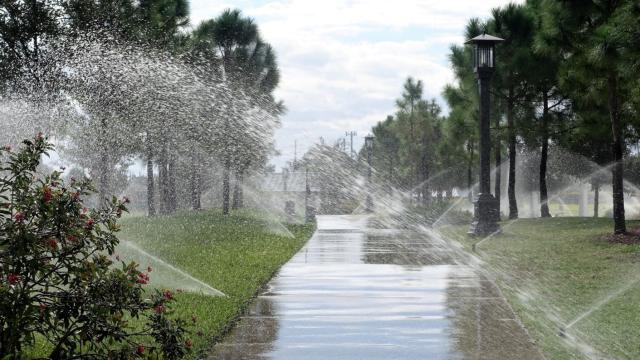Many commercial facilities use a significant amount of water to maintain and irrigate their surrounding landscape. Facilities with large areas of maintained landscape — such as schools and office buildings — can use as much as 30% of their water for irrigation, according to the U.S. Environmental Protection Agency (EPA). By using smart irrigation controllers and water-efficient fixtures, you can significantly reduce water use and save money.
Irrigation controllers
An existing irrigation system can be optimized by upgrading the control mechanism or other components. Consider replacing conventional clock-timer controllers with more advanced control systems that water plants only when needed.
Advanced irrigation controllers use local weather and landscape conditions to determine when and how much to water. To work effectively, these controllers must be installed and programmed properly. Have your controller installed by an experienced irrigation professional.
Soil moisture-based control technologies can be inserted into the soil to measure moisture, regulating irrigation so that it only occurs when soil moisture falls below a set threshold. These sensors can be connected to an existing controller, or be installed in a new system to enable irrigation as needed by plants.
Also, consider installing rain-sensing control technology. This will help to prevent water waste from irrigating during periods of sufficient rainfall.
Sprinkler systems
Upgrades to irrigation system components also offer opportunities for water savings.
Landscape irrigation sprinklers are often installed at sites where the system pressure is higher than what is recommended for the sprinkler nozzle. This can lead to excessive flow rates and uneven coverage. The EPA estimates that 63% of irrigation systems operate at pressures higher than the recommended operating pressures for the spray nozzles.
Water-efficient sprinkler bodies with integral pressure regulation can provide a constant flow at the sprinkler nozzle to help reduce water waste and provide a more even distribution of water over the landscape. Also, consider installing sprinklers with check valves, which retain water in piping rather than draining it. This reduces the amount of water needed in the next irrigation cycle.
Trees, shrubs and plant beds often don't require the spray systems traditionally used for turf areas. Consider upgrading these areas with drip irrigation systems, which direct water to plant roots at a low-flow rate, avoiding water waste from evaporation or runoff. This technology uses 20% to 50% less water than traditional sprinkler systems, according to the EPA.
When upgrading your landscaping irrigation system, make sure to use WaterSense-labeled irrigation controllers and spray sprinkler bodies. WaterSense products are independently tested and certified to meet EPA specifications for water efficiency and performance.
Save Money With Rebates
We offer generous rebates for smart controllers and water-efficient sprinkler heads, along with rebates for replacing thirsty grass lawns with drought-tolerant landscaping. Learn more about our water conservation rebates for commercial customers on our website.
June 2024 Connections Newsletter
From industry trends and best practices to sustainability initiatives, our monthly Connections Newsletter provides valuable insights, updates, and resources to support our large business customers.
